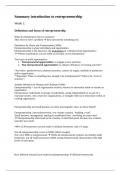Summary introduction to entrepreneurship
Week 1:
Definitions and forms of entrepreneurship
What do entrepreneurs have in common?
They tried to solve a problem they innovate/do something new.
Definitions by Shane and Venkataraman (2000):
Entrepreneurship is about individuals and opportunities.
Entrepreneurship is the discovery and exploitation of ‘entrepreneurial opportunities’.
Without exploitation, you are solely an inventor, not an entrepreneur
Two types of profit opportunities:
1. Entrepreneurial opportunities: to engage in new activities.
2. Non-entrepreneurial opportunities: to enhance efficiency of existing activities*.
*Activities= goods/services, markets/customers, sources of supply, methods of production
and/or organization.
**Important: When is something new enough to be entrepreneurial? What is the ‘level of
newness’?
Another definition by Sharma and Chrisman (1999):
Entrepreneurship = acts of organization creation, renewal or innovation inside or outside an
organization
Entrepreneurs: individuals or groups of individuals, acting independently or as part of a
corporate system, who create new organizations, or instigate renewal or innovation within an
existing organization.
Entrepreneurship and small business are often used together. How are these linked?
Entrepreneurship: innovation/renewal, new venture creation, ‘building a road’.
Small business: management, running an established firm, ‘travelling an extant road’.
Entrepreneurship often leads to the creation of small businesses because new ventures
typically start small.
*99% of all businesses concern small or medium businesses, only 1% large.
Not all entrepreneurship occurs in SMEs (Shell, Google).
Not every SME is entrepreneurial While all entrepreneurial ventures are initially small
businesses, not all small businesses exhibit strong entrepreneurial characteristics like high
levels of innovation.
How different research have looked at entrepreneurship different frameworks.
,Schools of thoughts framework by Kuratko et al. 2015:
Divides entrepreneurship into specific activities/perspectives, which all address the
conceptual nature of entrepreneurship. Each school emphasizes different factors that play a
role in the emergence and development of entrepreneurship.
Macro view, concerns external processes that are sometimes beyond the control of the
individual entrepreneurs:
- Environmental school of thought deals with the external factors that affect a
potential entrepreneur’s motivation and ability to start a venture.
- Financial/capital school of thought focuses on entrepreneurs and the process
through which they seek financial capital.
- Displacement school of thought looking at individuals who feel displaced in a
society ( therefore become an entrepreneur)
Micro view, examines the factors that are specific to the entrepreneur’s ability to direct or
adjust the outcome of each major influence in this view:
- Entrepreneurial trait school of thought personality traits and how they affect
decisions and outcomes.
- Venture opportunity school of thought focusing on opportunities. The search for
idea sources, the development of concepts, and the implementation of venture
opportunities.
- Strategic formulation school of thought the effects of business planning on venture
survival and performance.
Integrative framework. (process framework)
This model is built around the concepts of input to the entrepreneurial process and outcomes
from the entrepreneurial process.
- Persuit of the process requires an entrepreneur
- The environment can facilitate or constrain the entrepreneur ‘rules of the game’
that determine how the entrepreneurial impulse of individuals is channeled.
- The (business) concept represents a total value package (value propositions)
- Resources influence the ability to match a concept to an opportunity (financial,
human, distribution channels, technologies, etc.)
- Finally, entrepreneurship requires some sort of organizational context, and this context
often has implications for the type and timing of entrepreneurial activity.
, It can be seen that the entrepreneurial process is the result of numerous interactions among a
number of variables: the organizational context, the environment, the entrepreneur, the
resources & the concept integrative framework for the entrepreneurial process.
Venture typology framework: way to distinguish types of ventures.
*Corporate venturing is a strategy used by established companies to invest in, collaborate
with, or create new ventures.
Other distinctions could be based on size of the venture, revenue, employees, amount of
growth, etc.




